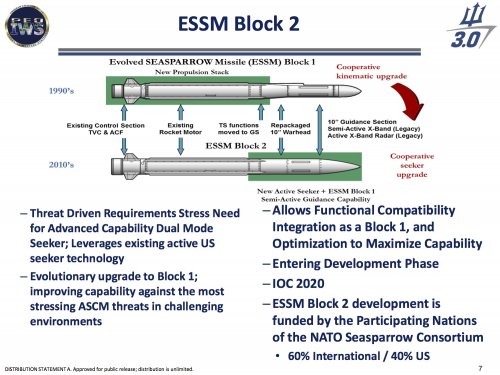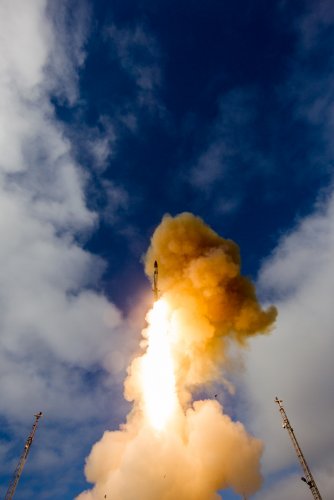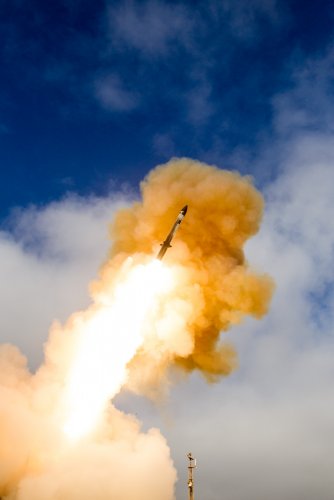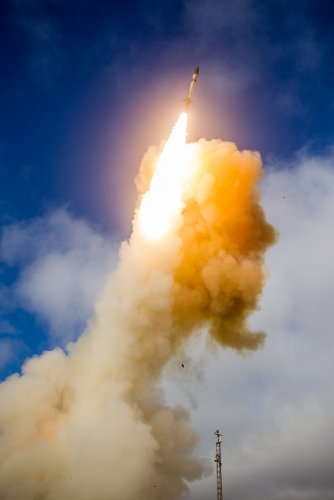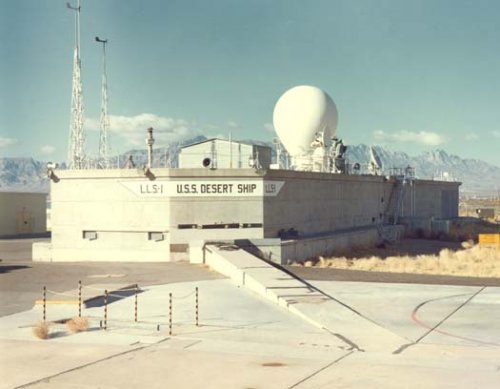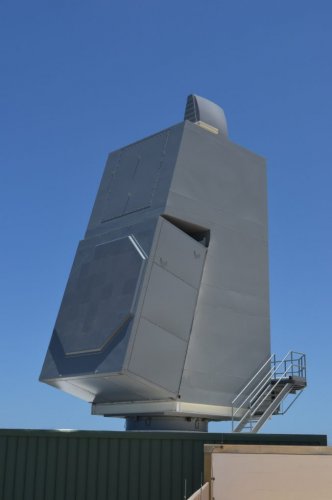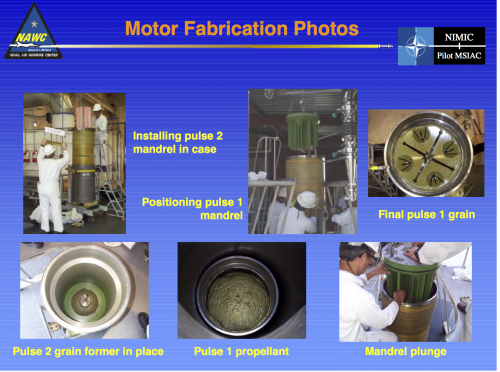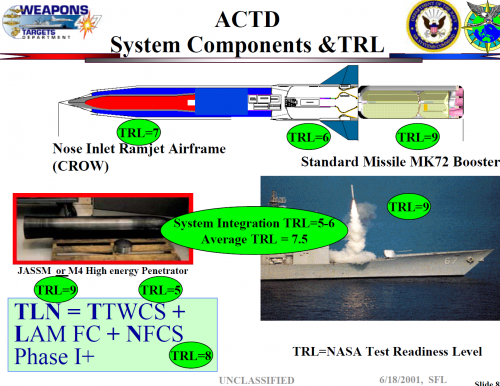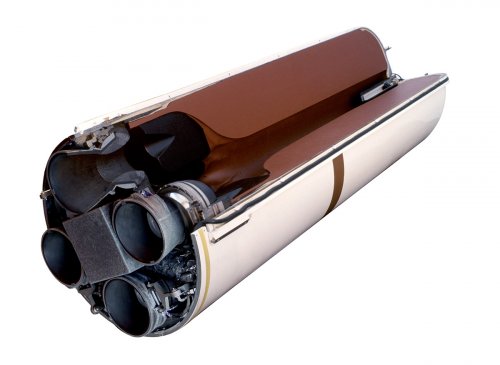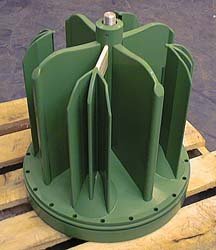You are using an out of date browser. It may not display this or other websites correctly.
You should upgrade or use an alternative browser.
You should upgrade or use an alternative browser.
AMDR ships
- Thread starter Grey Havoc
- Start date
Document: Navy Report to Congress on Flight III Destroyers
March 4, 2015 9:29 PM
The following is the Feb. 23, 2015 Assistant Secretary of the Navy Research, Development, and Acquisition (RD&A) report to Congress, DDG 51 Flight III Ships Air and Missile Defense Radar Engineering Change Proposal.
Source:
http://news.usni.org/2015/03/04/document-navy-report-to-congress-on-flight-iii-destroyers#more-11445
March 4, 2015 9:29 PM
The following is the Feb. 23, 2015 Assistant Secretary of the Navy Research, Development, and Acquisition (RD&A) report to Congress, DDG 51 Flight III Ships Air and Missile Defense Radar Engineering Change Proposal.
Source:
http://news.usni.org/2015/03/04/document-navy-report-to-congress-on-flight-iii-destroyers#more-11445
marauder2048
"I should really just relax"
- Joined
- 19 November 2013
- Messages
- 3,157
- Reaction score
- 926
Colonial-Marine
UAVs are now friend, drones are the real enemy.
- Joined
- 5 October 2009
- Messages
- 1,461
- Reaction score
- 1,314
Seems we're trying to match the Royal Navy for "fitted for but not with" capability.sferrin said:And they still build that platform in front of the bridge and then put nothing on it? (No CIWS or RAM?)
So Flight III won't have a stretched hull or anything?
Colonial-Marine said:Seems we're trying to match the Royal Navy for "fitted for but not with" capability.
I'm sure the other guys will be all kinds of impressed when we try to call "time out!" so we can paddle home and put weapons on them. :
- Joined
- 16 April 2008
- Messages
- 9,558
- Reaction score
- 14,341
Leaving that CIWS platform is simple economics. Redesigning that area is a change order that costs a bunch of money, but leaving it alone is basically free (the cost of the extra steel pales beside the cost of the ECP). Plus it gives you some free storage space.
Stretching the hull was not viable. The problem is that you can't mess with anything between the stacks and the props without changing the shaftline geometry, which is likewise expensive from a design perspective (a point in favor of electric drive). Forward of that is about where the hull stops being straight, so you can't insert a stretch by adding a simple plug.
Stretching the hull was not viable. The problem is that you can't mess with anything between the stacks and the props without changing the shaftline geometry, which is likewise expensive from a design perspective (a point in favor of electric drive). Forward of that is about where the hull stops being straight, so you can't insert a stretch by adding a simple plug.
marauder2048 said:That's a mighty fine radome.
The difference between ESSM and SLAMRAAM-ER seems to be getting less and less. Though it is odd that with the ER they went from a notional full diameter nose to a necked-down design, like ESSM Block I, but then did just the opposite for ESSM Block II.
- Joined
- 4 July 2010
- Messages
- 2,509
- Reaction score
- 3,070
The actual CIWS bolt-on could be done pretty rapidly in an emergency, and even without it the Burke is far from defenseless. The other mount and ESSM aren't nothing.sferrin said:Colonial-Marine said:Seems we're trying to match the Royal Navy for "fitted for but not with" capability.
I'm sure the other guys will be all kinds of impressed when we try to call "time out!" so we can paddle home and put weapons on them. :
I had a large post on this topic over on MPnet before it went teets-up, but in short the forward mounts haven't been included in the initial fitting-out for some time but they show up pretty rapidly as the destroyers go though their regularly scheduled yard periods.
Moose said:The actual CIWS bolt-on could be done pretty rapidly in an emergency, and even without it the Burke is far from defenseless. The other mount and ESSM aren't nothing.sferrin said:Colonial-Marine said:Seems we're trying to match the Royal Navy for "fitted for but not with" capability.
I'm sure the other guys will be all kinds of impressed when we try to call "time out!" so we can paddle home and put weapons on them. :
I had a large post on this topic over on MPnet before it went teets-up, but in short the forward mounts haven't been included in the initial fitting-out for some time but they show up pretty rapidly as the destroyers go though their regularly scheduled yard periods.
As the Stark found out, many times the first hint of "emergency" is when the missile is inbound. A bit late at that point.
- Joined
- 16 April 2008
- Messages
- 9,558
- Reaction score
- 14,341
You misssed the observation that the ships are getting Phalanx in their yard availabilities. Those happen before the ships deploy. Unless we're worried about surprise missile attacks in US waters, this should be sufficient.
TomS said:You misssed the observation that the ships are getting Phalanx in their yard availabilities.
Yep. Missed that. :-[
"Raytheon Successfully Completes Critical Design Review for AMDR"
By: Sam LaGrone
May 14, 2015 11:41 AM
Source:
http://news.usni.org/2015/05/14/raytheon-successfully-completes-critical-design-review-for-amdr
By: Sam LaGrone
May 14, 2015 11:41 AM
Source:
http://news.usni.org/2015/05/14/raytheon-successfully-completes-critical-design-review-for-amdr
The Raytheon-built Air and Missile Defense Radar (AMDR) has successfully completed its Navy critical design review (CDR) ahead of more hardware development efforts later this summer, company officials told USNI News this week.
According to the company, the AMDR — now designated AN/SPY-6(v) — passed or exceeded technical performance measures in tests allowing the company to proceed to the next phases of the design and building effort of the radar.
“We have achieved or exceeded all of those technical performance measures,” Tad Dickenson Raytheon’s program manager for AMDR told USNI News this week.
“The basic report card is that we have more than 20 technical performance measures which are anything from simple things — like size weight and power — to more complex things — like jammer suppression or single pulse sensitivity.”
The company had completed the preliminary design review (PDR) for the radar last year.
The AMDR will be the new active electronically scanned array (AESA)S-band radar onboard the Arleigh Burke Flight III guided missile destroyers (DDG-51). The first of the ships will start construction in Fiscal Year 2016 as part of a ten ship multi-year procurement deal the service inked in 2013.
Raytheon is also building a radar suite controller and the Navy will use the Northrop Grumman AN/SPQ-9B (nicknamed: spook 9 Bee) as the X-band radar for the Flight IIIs for now.
The radar promise to provide a 30-times boost in sensitivity over the current Lockheed Martin AV/SPY-1D radars found on current Burkes, the Navy has said.
Raytheon is currently working on an engineering development model ahead of a full radar delivery in May of 2017 to meet the construction schedule of the new Flight IIIs.
marauder2048
"I should really just relax"
- Joined
- 19 November 2013
- Messages
- 3,157
- Reaction score
- 926
SM-3 Block IIA has flown:
The Technical Research and Development Institute (TRDI), Japan Ministry of Defense (MOD), and the U.S. Missile Defense Agency (MDA), in cooperation with the U.S. Navy, announced the successful completion of a Standard Missile-3 (SM-3) Block IIA flight test from the Point Mugu Sea Range, San Nicolas Island, California. This test, designated SM-3 Block IIA Cooperative Development Controlled Test Vehicle-01, was the first live fire of the SM-3 Block IIA. The missile successfully demonstrated flyout through nosecone deployment and third stage flight. No intercept was planned, and no target missile was launched.
Attachments
- Joined
- 21 April 2009
- Messages
- 13,713
- Reaction score
- 7,588
sferrin said:Nice! Hope they release some close-ups in the days to come.
Cross posted on the SM-3 Developments threadmarauder2048 said:SM-3 Block IIA has flown:
The Technical Research and Development Institute (TRDI), Japan Ministry of Defense (MOD), and the U.S. Missile Defense Agency (MDA), in cooperation with the U.S. Navy, announced the successful completion of a Standard Missile-3 (SM-3) Block IIA flight test from the Point Mugu Sea Range, San Nicolas Island, California. This test, designated SM-3 Block IIA Cooperative Development Controlled Test Vehicle-01, was the first live fire of the SM-3 Block IIA. The missile successfully demonstrated flyout through nosecone deployment and third stage flight. No intercept was planned, and no target missile was launched.
More SM6 testing. I wondered what that "Desert Ship" was so I looked it up.
http://www.asdnews.com/news-61863/US_Navy_Uses_SM-6_to_Intercept_Medium-Range_Supersonic_Target_from__Over-the-Horizon_.htm
US Navy Uses SM-6 to Intercept Medium-Range Supersonic Target from 'Over-the-Horizon'

 click to enlargeThe U.S. Navy's USS Desert Ship (LLS-1) crew fired a Raytheon Company (NYSE: RTN) Standard Missile-6 at a medium-range supersonic target, successfully engaging the simulated 'over-the-horizon' threat. This mission was the next in a test series for Naval Integrated Fire Control – Counter Air (NIFC-CA), a program designed to link U.S. Navy ships and airborne sensors into a single network."This flight test is yet another demonstration of SM-6 providing the U.S. Navy with critical defensive capabilities against emerging threats," said Capt. Michael Ladner, Program Executive Office, Integrated Weapon Systems (PEO IWS) 3.0 Surface Ship Weapons major program manager.
click to enlargeThe U.S. Navy's USS Desert Ship (LLS-1) crew fired a Raytheon Company (NYSE: RTN) Standard Missile-6 at a medium-range supersonic target, successfully engaging the simulated 'over-the-horizon' threat. This mission was the next in a test series for Naval Integrated Fire Control – Counter Air (NIFC-CA), a program designed to link U.S. Navy ships and airborne sensors into a single network."This flight test is yet another demonstration of SM-6 providing the U.S. Navy with critical defensive capabilities against emerging threats," said Capt. Michael Ladner, Program Executive Office, Integrated Weapon Systems (PEO IWS) 3.0 Surface Ship Weapons major program manager.
http://www.asdnews.com/news-61863/US_Navy_Uses_SM-6_to_Intercept_Medium-Range_Supersonic_Target_from__Over-the-Horizon_.htm
US Navy Uses SM-6 to Intercept Medium-Range Supersonic Target from 'Over-the-Horizon'

 click to enlargeThe U.S. Navy's USS Desert Ship (LLS-1) crew fired a Raytheon Company (NYSE: RTN) Standard Missile-6 at a medium-range supersonic target, successfully engaging the simulated 'over-the-horizon' threat. This mission was the next in a test series for Naval Integrated Fire Control – Counter Air (NIFC-CA), a program designed to link U.S. Navy ships and airborne sensors into a single network."This flight test is yet another demonstration of SM-6 providing the U.S. Navy with critical defensive capabilities against emerging threats," said Capt. Michael Ladner, Program Executive Office, Integrated Weapon Systems (PEO IWS) 3.0 Surface Ship Weapons major program manager.
click to enlargeThe U.S. Navy's USS Desert Ship (LLS-1) crew fired a Raytheon Company (NYSE: RTN) Standard Missile-6 at a medium-range supersonic target, successfully engaging the simulated 'over-the-horizon' threat. This mission was the next in a test series for Naval Integrated Fire Control – Counter Air (NIFC-CA), a program designed to link U.S. Navy ships and airborne sensors into a single network."This flight test is yet another demonstration of SM-6 providing the U.S. Navy with critical defensive capabilities against emerging threats," said Capt. Michael Ladner, Program Executive Office, Integrated Weapon Systems (PEO IWS) 3.0 Surface Ship Weapons major program manager.Attachments
4 new SM6 missile intercepts:
http://www.mda.mil/news/15news0007.html
Event 1
On July 28, at approximately 10:30 p.m. Hawaii Standard Time (July 29, 4:30 a.m. Eastern Daylight Time), a short-range ballistic missile (SRBM) target was launched from PMRF in a northwesterly trajectory. The USS John Paul Jones, positioned west of Hawaii, detected, tracked, and launched a SM-6 Dual I missile, resulting in a successful target intercept.
Event 2
On July 29, at approximately 8:15 p.m. Hawaii Standard Time (July 30, 2:15 a.m. Eastern Daylight Time), a short-range ballistic missile (SRBM) target was launched from PMRF in a northwesterly trajectory. The USS John Paul Jones detected, tracked, and launched a SM-2 Block IV missile, resulting in a successful target intercept.
Event 3
On July 31, at approximately 2:30 p.m. Hawaii Standard Time, (8:30 p.m. Eastern Daylight Time) an AQM-37C cruise missile target was air-launched to replicate an air-warfare threat. The USS John Paul Jones detected, tracked, and successfully engaged the target using an SM-6 Dual I missile.
Event 4
On August 1, at approximately 3:45 p.m. Hawaii Standard Time, (9:45 p.m. Eastern Standard Time), a BQM-74E cruise missile target was launched from PMRF. The USS John Paul Jones detected, tracked, and successfully engaged the target using an SM-6 Dual I missile. The SM-6's proximity-fuze warhead was programmed not to detonate after reaching the lethal distance from the target, thus providing the ability to recover and reuse the BQM-74E target.
http://www.mda.mil/news/15news0007.html
Event 1
On July 28, at approximately 10:30 p.m. Hawaii Standard Time (July 29, 4:30 a.m. Eastern Daylight Time), a short-range ballistic missile (SRBM) target was launched from PMRF in a northwesterly trajectory. The USS John Paul Jones, positioned west of Hawaii, detected, tracked, and launched a SM-6 Dual I missile, resulting in a successful target intercept.
Event 2
On July 29, at approximately 8:15 p.m. Hawaii Standard Time (July 30, 2:15 a.m. Eastern Daylight Time), a short-range ballistic missile (SRBM) target was launched from PMRF in a northwesterly trajectory. The USS John Paul Jones detected, tracked, and launched a SM-2 Block IV missile, resulting in a successful target intercept.
Event 3
On July 31, at approximately 2:30 p.m. Hawaii Standard Time, (8:30 p.m. Eastern Daylight Time) an AQM-37C cruise missile target was air-launched to replicate an air-warfare threat. The USS John Paul Jones detected, tracked, and successfully engaged the target using an SM-6 Dual I missile.
Event 4
On August 1, at approximately 3:45 p.m. Hawaii Standard Time, (9:45 p.m. Eastern Standard Time), a BQM-74E cruise missile target was launched from PMRF. The USS John Paul Jones detected, tracked, and successfully engaged the target using an SM-6 Dual I missile. The SM-6's proximity-fuze warhead was programmed not to detonate after reaching the lethal distance from the target, thus providing the ability to recover and reuse the BQM-74E target.
fredymac said:4 new SM6 missile intercepts:
http://www.mda.mil/news/15news0007.html
Event 1
On July 28, at approximately 10:30 p.m. Hawaii Standard Time (July 29, 4:30 a.m. Eastern Daylight Time), a short-range ballistic missile (SRBM) target was launched from PMRF in a northwesterly trajectory. The USS John Paul Jones, positioned west of Hawaii, detected, tracked, and launched a SM-6 Dual I missile, resulting in a successful target intercept.
Event 2
On July 29, at approximately 8:15 p.m. Hawaii Standard Time (July 30, 2:15 a.m. Eastern Daylight Time), a short-range ballistic missile (SRBM) target was launched from PMRF in a northwesterly trajectory. The USS John Paul Jones detected, tracked, and launched a SM-2 Block IV missile, resulting in a successful target intercept.
Event 3
On July 31, at approximately 2:30 p.m. Hawaii Standard Time, (8:30 p.m. Eastern Daylight Time) an AQM-37C cruise missile target was air-launched to replicate an air-warfare threat. The USS John Paul Jones detected, tracked, and successfully engaged the target using an SM-6 Dual I missile.
Event 4
On August 1, at approximately 3:45 p.m. Hawaii Standard Time, (9:45 p.m. Eastern Standard Time), a BQM-74E cruise missile target was launched from PMRF. The USS John Paul Jones detected, tracked, and successfully engaged the target using an SM-6 Dual I missile. The SM-6's proximity-fuze warhead was programmed not to detonate after reaching the lethal distance from the target, thus providing the ability to recover and reuse the BQM-74E target.
What is a "Dual I" missile?
Somewhat confusing explanation from Raytheon: http://www.raytheon.com/news/feature/gone_ballistic.html
He also noted that the version of SM-6 that has ballistic missile defense capability will be referred to as SM-6 ‘Dual 1.’
“When it deploys next year, it will be the only missile in the world capable of both anti-air warfare and ballistic missile defense from sea,” said Lawrence.
I would think all SM6 missiles would be capable of this. Might be just a software thing.
He also noted that the version of SM-6 that has ballistic missile defense capability will be referred to as SM-6 ‘Dual 1.’
“When it deploys next year, it will be the only missile in the world capable of both anti-air warfare and ballistic missile defense from sea,” said Lawrence.
I would think all SM6 missiles would be capable of this. Might be just a software thing.
- Joined
- 4 July 2010
- Messages
- 2,509
- Reaction score
- 3,070
Yes it's a software thing.fredymac said:Somewhat confusing explanation from Raytheon: http://www.raytheon.com/news/feature/gone_ballistic.html
He also noted that the version of SM-6 that has ballistic missile defense capability will be referred to as SM-6 ‘Dual 1.’
“When it deploys next year, it will be the only missile in the world capable of both anti-air warfare and ballistic missile defense from sea,” said Lawrence.
I would think all SM6 missiles would be capable of this. Might be just a software thing.
AMDR radar delivered to Pacific Missile Range for tests starting in July.
"Several months of testing at our near-field range facility, where the array completed characterization and calibration, have proven the system ready for live target tracking», said Raytheon’s Tad Dickenson, AMDR program director. «The array was the last component to ship. With all other components, including the back-end processing equipment, delivered earlier and already integrated at the range, AMDR will be up and running in short order"
http://www.dmitryshulgin.com/author/wagner666/
"Several months of testing at our near-field range facility, where the array completed characterization and calibration, have proven the system ready for live target tracking», said Raytheon’s Tad Dickenson, AMDR program director. «The array was the last component to ship. With all other components, including the back-end processing equipment, delivered earlier and already integrated at the range, AMDR will be up and running in short order"
http://www.dmitryshulgin.com/author/wagner666/
Attachments
marauder2048
"I should really just relax"
- Joined
- 19 November 2013
- Messages
- 3,157
- Reaction score
- 926
With the F-35 facilitated engage-on-remote SM-6 interception, this Lockheed report on a NIFC-CA simulation may be interesting.
The assumption here seems to be that the OTH engagements required fire control quality tracks which may be an upper bound on the bandwidth requirements.
The assumption here seems to be that the OTH engagements required fire control quality tracks which may be an upper bound on the bandwidth requirements.
Attachments
-
lockheed-nifc-ca.pdf1.1 MB · Views: 26
-
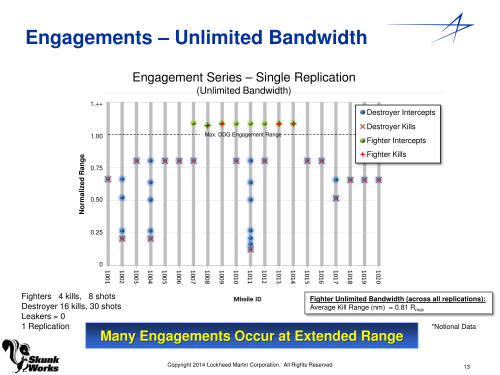 lockheed-nifc-ca-13.png187.9 KB · Views: 52
lockheed-nifc-ca-13.png187.9 KB · Views: 52 -
 lockheed-nifc-ca-12.png177.6 KB · Views: 46
lockheed-nifc-ca-12.png177.6 KB · Views: 46 -
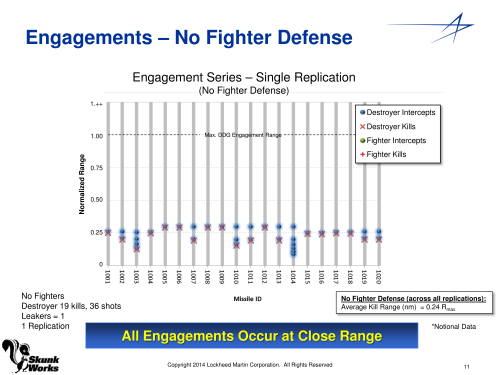 lockheed-nifc-ca-11.png175.9 KB · Views: 181
lockheed-nifc-ca-11.png175.9 KB · Views: 181 -
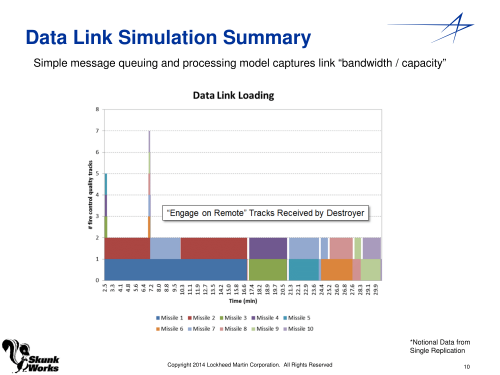 lockheed-nifc-ca-10.png156.3 KB · Views: 185
lockheed-nifc-ca-10.png156.3 KB · Views: 185 -
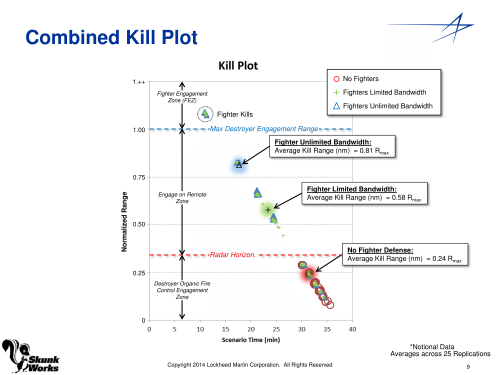 lockheed-nifc-ca-09.png167.7 KB · Views: 203
lockheed-nifc-ca-09.png167.7 KB · Views: 203 -
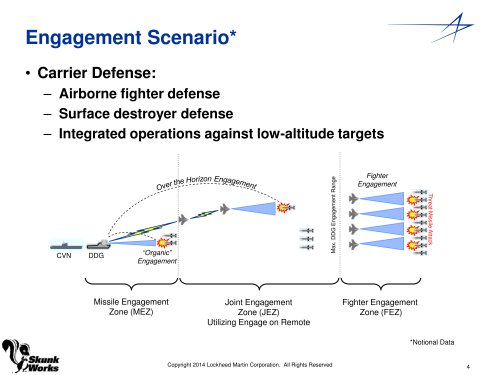 lockheed-nifc-ca-04.png144.7 KB · Views: 234
lockheed-nifc-ca-04.png144.7 KB · Views: 234
marauder2048 said:With the F-35 facilitated engage-on-remote SM-6 interception, this Lockheed report on a NIFC-CA simulation may be interesting.
The assumption here seems to be that the OTH engagements required fire control quality tracks which may be an upper bound on the bandwidth requirements.
Bandwidth between the F-35 and ship I take it? (The F-35 should be able to maintain a not insignificant number of engagement quality tracks with it's APG-81.) I wonder how frequently the tracks really need to be updated. If the target isn't maneuvering (which it likely wouldn't be 150 to 200 miles away from its destination) couldn't they optimize the amount of data required? Does the SM-6 really need millisecond to millisecond target information? Would be interesting to know the details. Also, I'd think having an off-platform source cuing SM-6 would add WAY more range, especially against low altitude targets.
marauder2048
"I should really just relax"
- Joined
- 19 November 2013
- Messages
- 3,157
- Reaction score
- 926
I presume it's F-35 <-> destroyer bandwidth since the destroyer gets 30% more OTH shots off in the unlimited bandwidth case.
It's in the slide deck pdf that the destroyer is modeled as supporting, at most, 10 simultaneous engagements.
IIRC, fighter -> A2A missile updates occur at like 1 - 2 Hz.
SM-6 might need reasonably good time-to-go info to determine when (if) to ignite the second pulse of the booster motor, booster separation time
and the coast period before the second stage kicks in.
It's in the slide deck pdf that the destroyer is modeled as supporting, at most, 10 simultaneous engagements.
IIRC, fighter -> A2A missile updates occur at like 1 - 2 Hz.
SM-6 might need reasonably good time-to-go info to determine when (if) to ignite the second pulse of the booster motor, booster separation time
and the coast period before the second stage kicks in.
- Joined
- 9 November 2008
- Messages
- 1,070
- Reaction score
- 164
There is an old video stating that the software can track ~100 objects with "Situational Awareness" and 8 Airborne & 16 Ground with "Weapons Quality".
Given that the NIFC-CA test claimed "hundreds" of tracks coming from the F-35 link, it's obvious the old video understated the capability.
Given that the NIFC-CA test claimed "hundreds" of tracks coming from the F-35 link, it's obvious the old video understated the capability.
marauder2048 said:I presume it's F-35 <-> destroyer bandwidth since the destroyer gets 30% more OTH shots off in the unlimited bandwidth case.
It's in the slide deck pdf that the destroyer is modeled as supporting, at most, 10 simultaneous engagements.
IIRC, fighter -> A2A missile updates occur at like 1 - 2 Hz.
SM-6 might need reasonably good time-to-go info to determine when (if) to ignite the second pulse of the booster motor, booster separation time
and the coast period before the second stage kicks in.
IIRC the sustainer isn't a dual-pulse motor. Stage 2 fires immediately after booster burnout. Also, once the F-35 has taken over, why would the destroyer even need to be in the loop?
marauder2048
"I should really just relax"
- Joined
- 19 November 2013
- Messages
- 3,157
- Reaction score
- 926
sferrin said:marauder2048 said:I presume it's F-35 <-> destroyer bandwidth since the destroyer gets 30% more OTH shots off in the unlimited bandwidth case.
It's in the slide deck pdf that the destroyer is modeled as supporting, at most, 10 simultaneous engagements.
IIRC, fighter -> A2A missile updates occur at like 1 - 2 Hz.
SM-6 might need reasonably good time-to-go info to determine when (if) to ignite the second pulse of the booster motor, booster separation time
and the coast period before the second stage kicks in.
IIRC the sustainer isn't a dual-pulse motor. Stage 2 fires immediately after booster burnout. Also, once the F-35 has taken over, why would the destroyer even need to be in the loop?
There was a IM compliant version of the MK-72 booster that was dual pulse.
With EOR, the F-35 doesn't have to take over provided the handoff to the active seeker on the missile is good enough.
Presumably you keep that track channel open to allow a quicker follow-up shot in the event of a miss.
Attachments
Do you know if they ever implemented it and if so what the reasoning was? Every launch video I've seen shows the booster burning in one pulse, for about 3-5 seconds, then dropping off. I have a picture of that mandral from another angle and always wondered what it went to.
marauder2048
"I should really just relax"
- Joined
- 19 November 2013
- Messages
- 3,157
- Reaction score
- 926
sferrin said:Do you know if they ever implemented it and if so what the reasoning was? Every launch video I've seen shows the booster burning in one pulse, for about 3-5 seconds, then dropping off. I have a picture of that mandral from another angle and always wondered what it went to.
No idea. I thought I've seen some videos where there looked to be two distinct pulses then the obvious staging event.
Two pulse makes a lot of sense particularly for a shorter range engagement where you need to pitch over quickly and separate.
* There is a MK-72 Mod 2 for SM-3 IIA which implies at least 3 different MK-72 variants.
marauder2048 said:Two pulse makes a lot of sense particularly for a shorter range engagement where you need to pitch over quickly and separate.
* There is a MK-72 Mod 2 for SM-3 IIA which implies at least 3 different MK-72 variants.
Depends on the profile. SM-3 doesn't pitch over all that quickly. I could see it maybe for SM-6. The first grain looks to be high thrust, low-time burn. Maybe it's just enough to pop the thing out of the cell and get it a few hundred feet above the ship then the second does the pitch over and the rest of the burn at a lower thrust level. At most you'd have a fraction of a second between burns. Still doesn't make much sense to me, as you could probably tailor a single grain to do the same thing, pack more fuel into the booster, and simplify the design. Obviously some reasoning went into it, I'd just like to know what it was.
edit: found this in an old report (2001). Obviously shows the two-pulse booster.
Attachments
1st picture is why I was skeptical of a 2-pulse booster (in addition to it seeming to be one continuous burn at launch). 2nd is the mandrel from the 1st pulse of the booster. I never put the two together because the mandrel obviously wouldn't produce the profile in the 1st picture.
Attachments
bring_it_on
I really should change my personal text
- Joined
- 4 July 2013
- Messages
- 3,624
- Reaction score
- 3,694
AMDR Update from Raytheon's 2016 Q4 Conference Call -
OPERATOR: Howard Rubel, Jefferies.
HOWARD RUBEL, ANALYST, JEFFERIES LLC: I want to go back to some of the accomplishments you have had in capturing some development programs. Tom, could you update us on the status of AMDR and when you expect that to start being inserted into the fleet? And the same applies to Next Gen Jammer and associated opportunities there as well.
TOM KENNEDY: Okay, so I'll start with AMDR. AMDR is in test at the Pacific test range out in Hawaii. It's having great results there. Obviously there is a lot of demand signals from the operational Navy side to get that into use as soon as possible. But initially, it goes onto DDG-51s in production, and then it goes into back-fit into the older DDG-51s. So we see a transition into -- starting a transition into production in the late 2018. There is also -- we've already been turned on to long lead for the AMDR and long lead material. But we see that picking up, essentially the production transition, in 2018 and beyond.
On Next Generation Jammer, Next Generation Jammer has entered into main EMD phase of that program. So that will also be transitioning into production in the 2020 type range. One other one you didn't mention, Howard, was we did win the Navy EASR program. Which is a smaller radar than AMDR but essentially based on the AMDR architecture. So between AMDR and EASR, we have the majority of the radars that go on surface Navy ships. And as you know, one of the keys of the administration's efforts moving forward is to increase the number of ships, which then will drive the number of EASRs and AMDRs that are going to be required. So we have a lot of expectations for those two franchises to take off here in the next 3 to 5 years.
marauder2048
"I should really just relax"
- Joined
- 19 November 2013
- Messages
- 3,157
- Reaction score
- 926
Moose said:Going to be some serious decisions around back-fit in the not-too-distant future. Something to keep an eye out for.
AMDR-X as well. Last I read, the Flight III as currently designed does have sufficient electrical capacity to
accommodate it so they may reconsider retrofitting AMDR-X to the first dozen Flight IIIs.
- Joined
- 4 July 2010
- Messages
- 2,509
- Reaction score
- 3,070
Yes. Several people on the "just build Burke variants forever" bandwagon are finding out just how fast they're running out of power margin. And that's for new-build, back-fit will require some hard decisions.
Moose said:Yes. Several people on the "just build Burke variants forever" bandwagon are finding out just how fast they're running out of power margin. And that's for new-build, back-fit will require some hard decisions.
*cough* Zumwalt.
marauder2048
"I should really just relax"
- Joined
- 19 November 2013
- Messages
- 3,157
- Reaction score
- 926
http://seapowermagazine.org/stories/20170202-greenert.html
Former CNO: Navy Reaching the Limits of its Afloat BMD Platform Capabilities
By RICHARD R. BURGESS, Managing Editor
WASHINGTON — The Navy has about 10 years to develop a new afloat ballistic-missile defense (BMD) system to keep pace with the threat, a former chief of naval operations (CNO) said.
“We don’t have a keel-up missile defense platform afloat,” retired Adm. Jonathan W. Greenert, told an audience Feb. 2 at a seminar sponsored by the Missile Defense Advocacy Alliance, noting that the Navy relied on BMD modifications to existing cruisers and destroyers.
He said the Navy had looked at adapting the large hull of a San Antonio-class amphibious platform dock ship, fitting a large-aperture radar on it to target a battery of BMD-capable missiles.
Greener said the San Antonio-class ships “can generate a lot of electricity” to power more capable radar systems.
“Imagine the size of aperture you could put on there — a TPY-2 [radar] easily, and probably double that — and you can put a lot of missiles in there,” he said.
Noting that the Navy is approaching the growth margin of its Ticonderoga-class cruisers and Arleigh Burke-class destroyers as BMD platforms, Greenert said “we are reaching the limits of our asymptote out there, and probably I’d say we’re probably 10 years from having to move on to another means afloat to meet the threat out there.”
Former CNO: Navy Reaching the Limits of its Afloat BMD Platform Capabilities
By RICHARD R. BURGESS, Managing Editor
WASHINGTON — The Navy has about 10 years to develop a new afloat ballistic-missile defense (BMD) system to keep pace with the threat, a former chief of naval operations (CNO) said.
“We don’t have a keel-up missile defense platform afloat,” retired Adm. Jonathan W. Greenert, told an audience Feb. 2 at a seminar sponsored by the Missile Defense Advocacy Alliance, noting that the Navy relied on BMD modifications to existing cruisers and destroyers.
He said the Navy had looked at adapting the large hull of a San Antonio-class amphibious platform dock ship, fitting a large-aperture radar on it to target a battery of BMD-capable missiles.
Greener said the San Antonio-class ships “can generate a lot of electricity” to power more capable radar systems.
“Imagine the size of aperture you could put on there — a TPY-2 [radar] easily, and probably double that — and you can put a lot of missiles in there,” he said.
Noting that the Navy is approaching the growth margin of its Ticonderoga-class cruisers and Arleigh Burke-class destroyers as BMD platforms, Greenert said “we are reaching the limits of our asymptote out there, and probably I’d say we’re probably 10 years from having to move on to another means afloat to meet the threat out there.”
Similar threads
-
-
-
Report: Surface Forces CO Wants One LCS Design, Scrap DDG-51 Flight III
- Started by Triton
- Replies: 31
-
-

